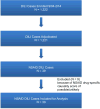Liver injury from nonsteroidal anti-inflammatory drugs in the United States
- PMID: 26601797
- PMCID: PMC5035108
- DOI: 10.1111/liv.13032
Liver injury from nonsteroidal anti-inflammatory drugs in the United States
Abstract
Background & aims: Nonsteroidal anti-inflammatory drugs (NSAIDs) are commonly used and have been associated with hepatotoxicity. Studies of liver injury from NSAIDs have been retrospective and prospective data are lacking. The aim was to report the features and outcomes of the subjects with severe drug-induced liver injury from NSAIDS.
Methods: The U.S. Drug Induced Liver Injury Network is a prospective registry of idiosyncratic drug hepatotoxicity. All patients are evaluated in a standard fashion and followed up for at least 6 months.
Results: Of 1221 Drug Induced Liver Injury Network cases that were adjudicated, 30 cases were attributed to eight different NSAIDs. The mean age was 52 years old, 24 (80%) were women, and 21 (70%) were Caucasian. The mean latency was 67 days. Common signs and symptoms at presentation were nausea (73%), jaundice (67%) and dark urine (67%). Mean peak serum aspartate aminotransferase, alanine aminotransferase, total bilirubin and alkaline phosphatase were 898 U/L, 1060 U/L, 12.2 mg/dl and 326 U/L. The most common pattern of injury was hepatocellular (70%) and autoantibodies were detected in 33% of cases. Diclofenac, was the most frequently implicated NSAID (16/30 cases), and characterized by hepatocellular injury. Seventeen cases resulted in hospitalization or prolongation of hospitalization and one patient died from complications of Stevens-Johnson syndrome because of diclofenac.
Conclusions: Hepatocellular injury is the most common pattern seen with NSAID hepatotoxicity, and diclofenac is the most frequently implicated agent. Given the number of NSAID alternatives, diclofenac should be reserved for patients who fail other NSAIDs and a high level of suspicion for hepatotoxicity should be maintained.
Keywords: diclofenac; hepatotoxicity; medication; nonsteroidal.
© 2015 John Wiley & Sons A/S. Published by John Wiley & Sons Ltd.
Conflict of interest statement
None
Figures
References
-
- Wolfe M, Lichtenstein D, Singh G. Gastrointestinal toxicity of nonsteroidal anti-inflammatory drugs. N Engl J Med. 1999;340:1888–1899. - PubMed
-
- Lichtenstein D, Sygal S, Wolfe M. Nonsteroidal anti-inflammatory drugs and the gastrointestinal tract: the double-edged sword. Arthritis Rheum. 1995;38:5–18. - PubMed
-
- Goldkind L, Laine L. A systematic review of NSAIDs withdrawn from the market due to hepatotoxicity: lessons learned from the bromfenac experience. Pharmacoepidemiol Drug Saf. 2006;15(4):213–220. - PubMed
-
- Bjornsson E. Review article: drug-induced liver injury in clinical practice. Aliment Pharmacol Ther. 2010;32:3–13. - PubMed
-
- Rostom A, Goldkind L, Laine L. Nonsteroidal anti-inflammatory drugs and hepatic toxicity: a systematic review of randomized controlled trials in arthritis patients. Clin Gastroenterol Hepatol. 2005;3:489–498. - PubMed
Publication types
MeSH terms
Substances
Grants and funding
LinkOut - more resources
Full Text Sources
Other Literature Sources
Medical



